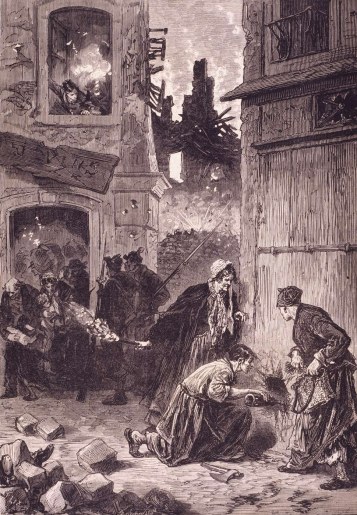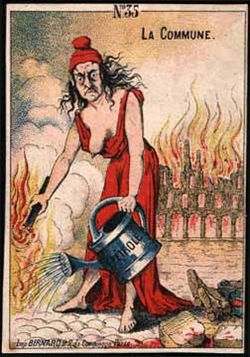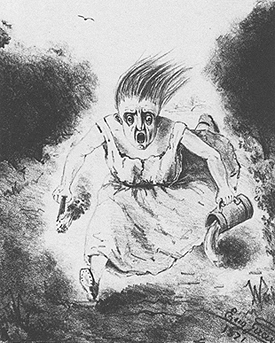By Lynn Clement
The near-mythical pétroleuse was one of the principal figures to emerge from the short-lived, yet radical Paris Commune (lasting from March 18, 1871 to May 28 of the same year). The pétroleuse represented those women accused of setting devastating fires that gutted government and cultural institutions during the Semaine Sanglant (The Bloody Week, which lasted from May 21st to May 28th, 1871). Historian Albert Boime observes that, “the right like the left often symbolized the Commune as a militant female…the mythical pétroleuse, the female incendiary who flouted her true nature,” and both the right and the left charged Communard women with sparking mob violence.[1] La pétroleuse’s lower-class character, too, speaks to mid-nineteenth century class tensions. In her book, Unruly Women of Paris: Images of the Commune, Gay Gullickson explains that, “[v]engeful proletarians…were dangerous enough. But women posed even greater threats to the social order.”[2] Damaging ideologies coalesced around the pétroleuse and as such, a study of these symbols of female destruction reveals the fears and tensions that surrounded French women’s political power and agency by way of the proletariat’s civil war and revolution. As punishment for stepping outside the prescribed social order, they were vilified in visual history, and slaughtered and exiled upon the downfall of the citizens’ regime at the hands of the Versailles government.
Contemporary accounts, and subsequent imagery dispersed by popular journals, asserted that this breed of “un-natural” women violated traditional gender roles by joining the political discourse and fighting. While the Paris Commune is a narrow period of French history, it is significant in its record of the contemporary responses to women’s involvement in rebellion and political affairs. Women who participated in the revolution of 1871 felt that the Commune would finally succeed where previous revolutions had failed, and as activist and founder of the Union des Femmes, Elisabeth Dmitrieff, has stated, these women felt that they could achieve “the creation of a new social order” founded on “equality, solidarity and of freedom.”[3] However, rather than securing equality through their participation in political clubs, their defense of Paris during the Franco-Prussian war and subsequent siege, or their sacrifice on the barricades, Communard women were demonized for their entrance into French politics and were forever immortalized in the archetype of the pétroleuse.

The feminist historian, Madelyn Gutwirth, argues that “[t]he ontological void women represent to the male culture apparently provides a perfect vehicle for the use of the female figure to represent virtually anything…it offers us a culturally sanctioned, rigid assimilation of diverse and even warring phenomena to a predetermined sign.”[4] I would argue that depictions of the pétroleuse, in addition to negative depictions of Republican France in the guise of these incendiaries, unify disparate ideologies regarding the Commune into one symbol of destruction: women. The use of the female body as political symbol is longstanding. For example, representing the quest for liberty, equality, and fraternity, the allegorical female emblem, Marianne, originated during the revolution of 1789 and soon became an accepted and celebrated national symbol of France.[5] Physical representations appear in the early nineteenth century and took inspiration from classicized personifications of Liberty and the Republic.[6] In Delacroix’s famous example, Liberty is personified as a bare-breasted woman donning a Phrygian cap (a symbol dating back to ancient Rome when the hat was worn by freed slaves).[7] Striding swiftly over the casualties of revolution, she raises the tricolore with one statuesque arm while gripping the barrel of a bayonetted rifle in the other. Meanwhile, in Honoré Daumier’s painting, The Republic, she is seated upon a throne, donning the Phrygian cap, and while grasping the tricolore tightly in muscular arms, she nurses her children of liberty.
In direct contrast is a depiction of Marianne created after the suppression of the Commune. This virago simultaneously pours petrol from a watering can while torching her surroundings. Behind her a Roman-arched structure, reminiscent of contemporary photographs of the structures gutted by fire, is already aflame. This incendiary Marianne bellicosely stares out at the viewer with a repugnant face, her traditional flowing dark hair wild and ragged, while her dress, now red to signify the symbolic color of the Commune, slips from her shoulder to reveal one wilted breast. This bare breast that once nourished the children of liberty is now imagined as its grossly deformed and dysfunctional counterpart. Barefoot she stands upon the cobbled streets of Paris, stones of which have been uprooted to form the barricade that we imagine lay just outside the picture frame. In the same corner lies another product of her destruction — the lifeless legs and feet of a soldier. It does not matter if they belong to a Communard or a Versailles soldier; she brings devastation to all and represents France amidst bloody civil war. In addition, this incendiary Marianne represents the fear associated with those women who participated in the Commune — the personification of France transformed since female allegorical figures were malleable and could be manipulated to signify social and political ideologies.
In Bernard’s image, the allegorical depiction of France has shifted to reflect what happens when women step outside acceptable gender roles as they did during the Commune. Images depicting the Communard women as destroyers of property and human life alike would have supported such writers as Michelet, Proudhon, and Comte who claimed that women were inferior physically, intellectually, and morally, and would have turned others in France against their plight. These images would also serve as warning for subsequent generations about the atrocities that can be meted out to the world when societal order is defied. Gullickson asserts that, “Virtually overnight, the representation of the dangerous, unruly female incendiary came to symbolize the evils of the Commune for its critics…”[8]
Eugène Girard’s image, sarcastically entitled The Emancipated Woman Shedding Light on the World, illustrates the perceived destruction that comes with female political power. Girard’s pétroleuse, or emancipated woman (now treated as one in the same), emerges from a smoky darkness illuminated by her inflamed torch in one hand, which is fueled by the canister of petrol held in the other. She confronts us with wide, fevered eyes, mouth agape, with hair that flies wildly as she races aggressively towards the viewer. Here the emancipated woman is to be feared; her illumination is not beneficial, it is dangerous. These sentiments were mirrored in contemporary accounts of the Communardes during their trials. Captain Jouenne, prosecutor at said trials, stated that,
The horrible campaign against civilization begun on March 18, by people who believe in neither God nor Country… and, alas, in great number—unworthy creatures who seem to have taken on the task of becoming an opprobrium to their sex, and… she becomes a moral monstrosity; then woman is more dangerous than the most dangerous man.[9]
Images like Girard’s directly reflect societal fears concerning the fight for female independence and agency through their participation in revolution.
Age and class are relevant in the analysis of the pétroleuse and explain the reason they were depicted as mature, wild, and menacing. The images of the Commune’s Marianne are damning and, I would argue, an allegory married to the demonized myth of the pétroleuse. Unlike idealized examples of Marianne that show her young, strong, and a protector of her people, here she is perverse. Here Marianne is depicted as a pétroleuse who destroys her city and represents militant, leftist Paris, completely out-of-control. She now conforms to contemporary stereotypes of the pétroleuse accused of burning down sections of Paris in the dying days of the Commune and creates a fearful image of violent, destructive, politically active, unfettered, and thus threatening women. As summarized by French writer and Communard, Benoît Malon:
Above all, one important fact that the Paris revolution brought to light is the entry of women into politics…they felt that the cooperation of women was indispensable to the triumph of the Social Revolution which had reached the fighting stage; the woman and the proletariat, those ultimate victims of the old order, could not hope for their emancipation except by forming a strong union against all the forces of the past.[10]
Lynn Clement is an adjunct professor of Art History at Northern Virginia Community College and the College of Southern Maryland. Her research focuses on Modern European art, feminist theory, political art, and the preservation of art in places of conflict. You can email her at lclementb@gmail.com or tweet her @lclementb.
Endnotes:
[1] Albert Boime, Art and the French Commune, (Princeton, New Jersey: Princeton University Press, 1997), 39.
[2] Gay Gullickson, Unruly Women of Paris: Images of the Commune, (Ithaca, New York: Cornell University Press, 1996), 58.
[3] John Milner, Art, War and Revolution in France, 1870-1871: Myth, Reportage, and Reality, (Hartford, Connecticut: Yale University Press, 2000).
[4] Madelyn Gutwirth. The Twilight of the Goddesses: Women and Representation in the French Revolutionary Era, (New Brunswick, New Jersey: Rutgers University Press, 1992).
[5] Maurice Agulhon, Marianne into Battle: Republican Imagery and Symbolism in France, 1789-1880, trans. Janet Lloyd, (Cambridge, Massachusetts: Cambridge University Press, 1981).
[6] Ibid, 82.
[7] Ibid, 2-4.
[8] Gullickson, 159.
[9] Edith Thomas, The Women Incendiaries, (Chicago, Illinois: Haymarket Books, 2007), 178-179.
[10] Quoted in ibid, xi.
Further Reading:
Bertall, The Communists of Paris, 1871: Types, Physiognomies, Characters. London; Buckinham and Co., 1871.
Clayson, Hollis, Paris in Despair: Art and Everyday Life Under Siege (1870-1871). Chicago: University of Chicago Press, 2002.
Merriman, John, Massacre: The Life and Death of the Paris Commune. New York: Basic Books, 2014.



Go Lynn 🙂 🙂
LikeLike
I read about this topic in Thomas Pynchon’s novel Against The Day and I immediately saw a connection to the Impressionist movement that started at the time
LikeLike